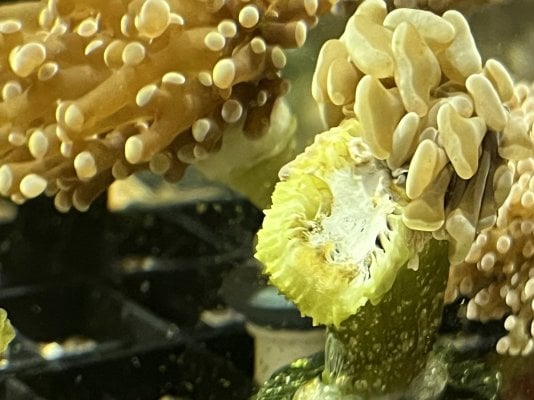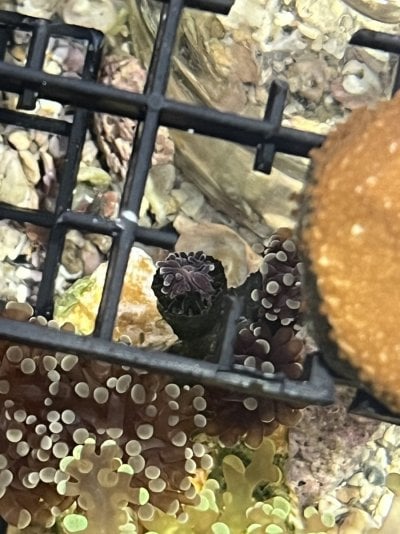Or, stated another way, how can I save my hammer and tank?
Tl;dr I’m trying to figure out whether chemical imbalances or fluctuations — gradual decrease of high phosphates over several weeks to 0.37 currently and incremental increase in alkalinity over last two weekends from 8.3-8.6 historical to 8.9 to 9.3 to 9.7 currently — and/or in-tank disturbance — ie, a way too active conch that I introduced in the last week knocking the hammer around and crawling on top of it — is causing my hammer to suddenly crash since last Friday, 1/26. At the same time, CA and MG have decreased notwithstanding commencement of all-for-reef for recent intro of large amount of corals in short period. Is the hammer is salvageable? The hammer looks for a bit like it’s stabilized and puffs up again and then looks like it is crashing again; it’s induced a seesaw of hope and despair. I haven’t seen any polyps bail out but in a few instances I see white streaks appearing as if it is melting away into the water column. I stopped dosing bc of the alk — should I refrain from dosing at all or dose only specific elements?
Pics attached of prior condition and progression over last several days (white lights unless glare made pics in blue more useable).
Long version of the situation:
I’ve had a hammer for a few months in one spot that’s historically been very puffy except when it retracts at night. I don’t have many pics of it bc it hadn’t presented any symptoms warranting my attention (as far as I could tell) but I’ve attached images from earlier this month, 1/5 , showing its usual spread.
Last Friday 1/26 I noticed that it wasn’t open as usual but that didn’t surprise me bc I had added a tiger conch into the frag tank — to replace the CUC I’m pretty sure are the victims of a fugitive gorilla crab — and it’s been spending a lot of time in the area where I keep hammers/frogspawns, particularly knocking around and sucking that hammer and to a lesser extent another branching hammer right in front of it (one of whose 5 heads also looks ticked off but not in a death spiral). Last Friday 1/26 the conch, which is about 2.5” long, spent a bunch of time right on top of the hammer’s head. Of course the hammer retracted. I meant to remove the conch but then got caught in a series of calls and forgot. Later that afternoon around 4pm, I noticed that the hammer’s polyps came back out but were not fully extended (see pics attached). Anyway, as you’ll see, either the polyps were progressively retracting in extreme manner or dying off or whatever — the skeleton was being exposed. Saturday 1/27 it appeared as if things had stabilized and the hammer appeared to puff up and fill most of the skeleton again (although not completely) but then appeared to go downhill later in day. Repeat that process several times throughout the remainder of Saturday and into Sunday 1/28 and today 1/29. Sometimes the polyps were deflated/limp — appearing like a succulent that’s dying from overwatering — but then later appeared to re-inflate.
So other things going on with the tank in the last two weeks: in short, phosphates have been high but slowly decreasing and alkalinity has been slowly going up.
I test phosphates and alkalinity at least once a week and the other major elements every other week. I do water changes 1 to 2 times a week, each time 10-25% per change. Except for a month when a beautiful but vicious storm clown spent detention there, the tank holds only frags waiting to go into the DT (delayed by indecision and constant reworking of the aquascape) so there is no feeding except twice a week when I target feed mysis and benereef or reefroids. I do occasionally throw in crab sticks and algae wavers for the CUC.
Stats from about two weeks ago:
1.025 salinity
77-78 degrees (remains unchanged)
~10 nitrates
0.66 phosphates (tank had been zero, I then overcorrected this fall, was on the way to bringing it back down but then discovered a gorilla crab, which led to a campaign of deploying traps using raw shrimp for like 2+ weeks without success (and achieved only increased phosphates), and then leading to current efforts).
Ph 8.1 (historically 8.1-8.3 range)
CA 480 (approx historical range)
MG 1560 (historically around 1480, high 1400s)
ALK 8.9 (historically, 8.3-8.6)
Around this time I just started to dose all-for-reef at or below recommended amount bc I was about to introduce approximately 30 corals — mostly LPS eg, “Euphyllia”, blastos, Gonis, acans, chalices but also some SPS, eg, one acro that became a victim of an Echinata and some of the encrusting variety — over a 10-day period because I lacked self control in the face of post-holiday temptations, so I figured I should make sure there were enough elements to sustain the increased population.
Last week:
1.025 salinity
5-10 nitrates
0.43 phosphates
9.3 alkalinity
Enter tiger conch
This Sunday (after small water change on Saturday):
1.025 salinity
5 nitrates
0.37 phosphates (and just added a bit of rowaphos under recommended amount)
9.7 KH
440 CA
1440 MG
8.0 oh
I assume the increase in alkalinity is due to the all for reef? Otherwise???? I stopped dosing Saturday or Sunday. But I have about another 10 corals coming in this week and if CA and MG decreased notwithstanding dosing, is stopping dosing prudent given the incoming additions? No sps, just hammers/frogs and gonis in the new orders (and some trochus so I can rehome the conch).
Other things going on with the tank that may also be impacting hammer:
I noticed the hammer bc 1/26 I was taking pic of a Pavona that keeps on shedding (as reflected in attached pic) — is that the right word? — no matter where I place it (which is what I was originally going to post about). I don’t think the same issue is impacting the hammer because it’s remain unchanged the entire time the Pavona has been peeling away and the hammer has never been near it.
In case more info needed to assess: I’ve had the pavona since October and around mid-December I noticed there was a small spot with exposed skeleton. It was placed near a setosa since mid-November. It hadn’t moved that much from its original location just off the perimeter of the AI prime. An Oregon tort went on the other side an inch away in early December and nothing else around that could potentially attack it. Thought the flesh — is that the right word??? — was perhaps impacted by too much light. But new location did not stop peeling so I’ve experimented with other locations re various light intensity and flow but 2/3 of one side of the Pavona is now stripped. I did notice this weekend a 3”+ sweeper coming out of a nearby Acan lord but problems predated bad neighbors.
Also, stomatellas had been very active in my tank — lots of algae courtesy of the phosphates — but they’ve disappeared in last two weeks. Though that coincides with reduction in phosphates and algae.
So is my hammer a goner? Should I stop dosing all-for-reef all together or use only element-specific additives? And any idea what’s going on with the Pavona?
Thanks all.
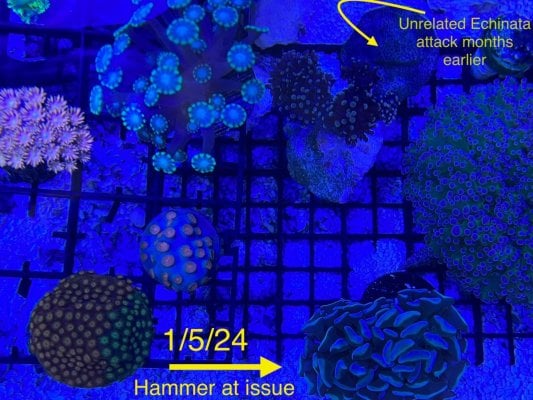
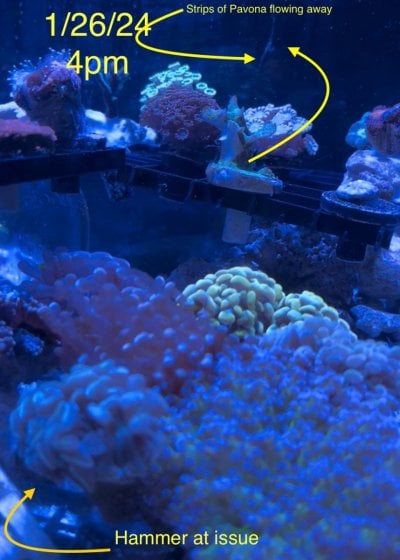
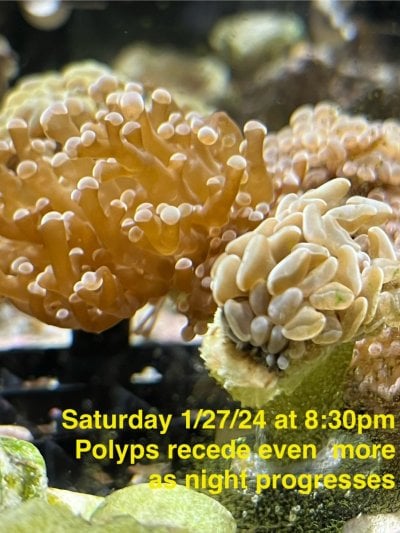
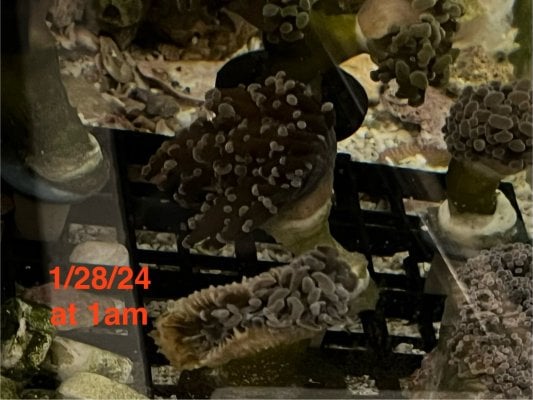
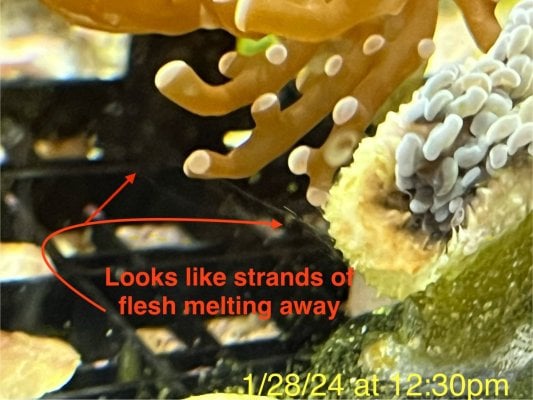
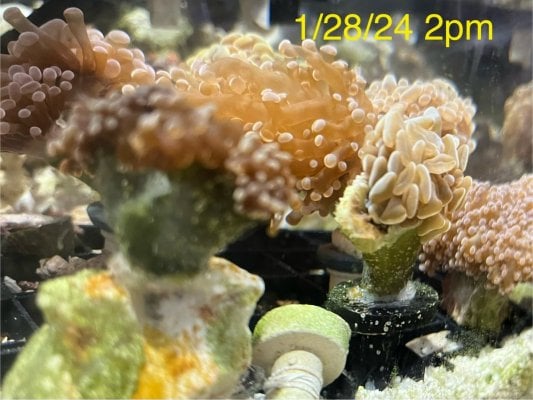
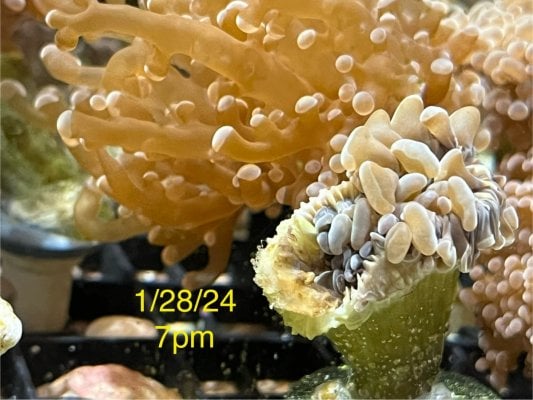
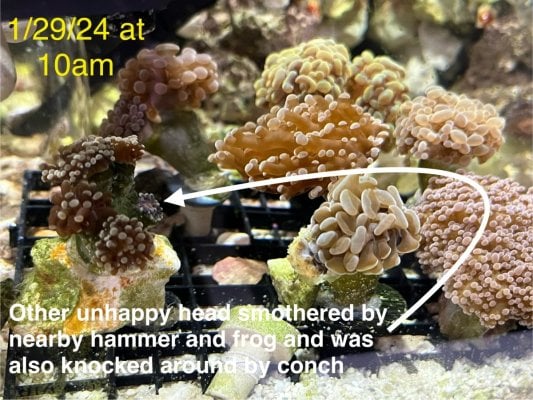
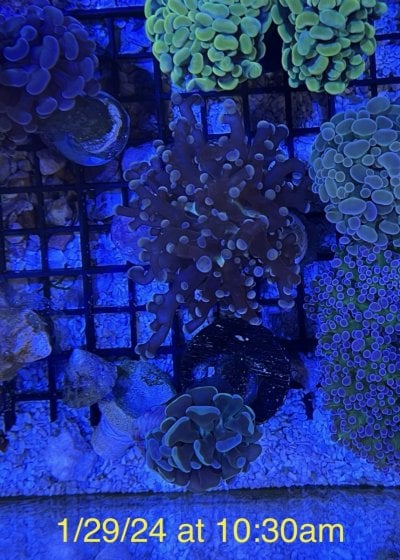
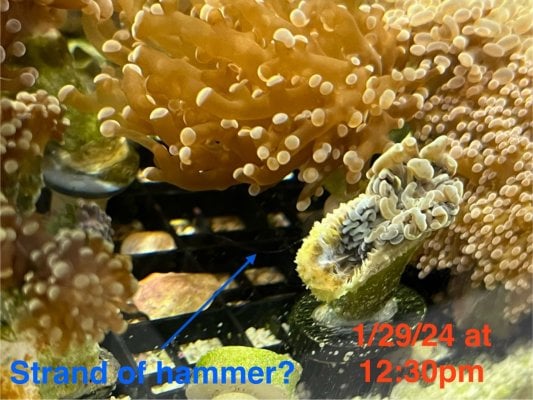
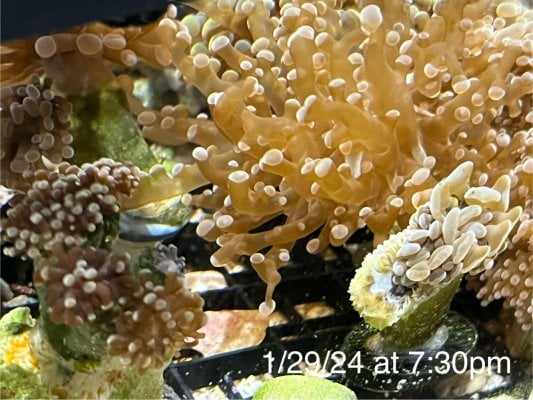
Tl;dr I’m trying to figure out whether chemical imbalances or fluctuations — gradual decrease of high phosphates over several weeks to 0.37 currently and incremental increase in alkalinity over last two weekends from 8.3-8.6 historical to 8.9 to 9.3 to 9.7 currently — and/or in-tank disturbance — ie, a way too active conch that I introduced in the last week knocking the hammer around and crawling on top of it — is causing my hammer to suddenly crash since last Friday, 1/26. At the same time, CA and MG have decreased notwithstanding commencement of all-for-reef for recent intro of large amount of corals in short period. Is the hammer is salvageable? The hammer looks for a bit like it’s stabilized and puffs up again and then looks like it is crashing again; it’s induced a seesaw of hope and despair. I haven’t seen any polyps bail out but in a few instances I see white streaks appearing as if it is melting away into the water column. I stopped dosing bc of the alk — should I refrain from dosing at all or dose only specific elements?
Pics attached of prior condition and progression over last several days (white lights unless glare made pics in blue more useable).
Long version of the situation:
I’ve had a hammer for a few months in one spot that’s historically been very puffy except when it retracts at night. I don’t have many pics of it bc it hadn’t presented any symptoms warranting my attention (as far as I could tell) but I’ve attached images from earlier this month, 1/5 , showing its usual spread.
Last Friday 1/26 I noticed that it wasn’t open as usual but that didn’t surprise me bc I had added a tiger conch into the frag tank — to replace the CUC I’m pretty sure are the victims of a fugitive gorilla crab — and it’s been spending a lot of time in the area where I keep hammers/frogspawns, particularly knocking around and sucking that hammer and to a lesser extent another branching hammer right in front of it (one of whose 5 heads also looks ticked off but not in a death spiral). Last Friday 1/26 the conch, which is about 2.5” long, spent a bunch of time right on top of the hammer’s head. Of course the hammer retracted. I meant to remove the conch but then got caught in a series of calls and forgot. Later that afternoon around 4pm, I noticed that the hammer’s polyps came back out but were not fully extended (see pics attached). Anyway, as you’ll see, either the polyps were progressively retracting in extreme manner or dying off or whatever — the skeleton was being exposed. Saturday 1/27 it appeared as if things had stabilized and the hammer appeared to puff up and fill most of the skeleton again (although not completely) but then appeared to go downhill later in day. Repeat that process several times throughout the remainder of Saturday and into Sunday 1/28 and today 1/29. Sometimes the polyps were deflated/limp — appearing like a succulent that’s dying from overwatering — but then later appeared to re-inflate.
So other things going on with the tank in the last two weeks: in short, phosphates have been high but slowly decreasing and alkalinity has been slowly going up.
I test phosphates and alkalinity at least once a week and the other major elements every other week. I do water changes 1 to 2 times a week, each time 10-25% per change. Except for a month when a beautiful but vicious storm clown spent detention there, the tank holds only frags waiting to go into the DT (delayed by indecision and constant reworking of the aquascape) so there is no feeding except twice a week when I target feed mysis and benereef or reefroids. I do occasionally throw in crab sticks and algae wavers for the CUC.
Stats from about two weeks ago:
1.025 salinity
77-78 degrees (remains unchanged)
~10 nitrates
0.66 phosphates (tank had been zero, I then overcorrected this fall, was on the way to bringing it back down but then discovered a gorilla crab, which led to a campaign of deploying traps using raw shrimp for like 2+ weeks without success (and achieved only increased phosphates), and then leading to current efforts).
Ph 8.1 (historically 8.1-8.3 range)
CA 480 (approx historical range)
MG 1560 (historically around 1480, high 1400s)
ALK 8.9 (historically, 8.3-8.6)
Around this time I just started to dose all-for-reef at or below recommended amount bc I was about to introduce approximately 30 corals — mostly LPS eg, “Euphyllia”, blastos, Gonis, acans, chalices but also some SPS, eg, one acro that became a victim of an Echinata and some of the encrusting variety — over a 10-day period because I lacked self control in the face of post-holiday temptations, so I figured I should make sure there were enough elements to sustain the increased population.
Last week:
1.025 salinity
5-10 nitrates
0.43 phosphates
9.3 alkalinity
Enter tiger conch
This Sunday (after small water change on Saturday):
1.025 salinity
5 nitrates
0.37 phosphates (and just added a bit of rowaphos under recommended amount)
9.7 KH
440 CA
1440 MG
8.0 oh
I assume the increase in alkalinity is due to the all for reef? Otherwise???? I stopped dosing Saturday or Sunday. But I have about another 10 corals coming in this week and if CA and MG decreased notwithstanding dosing, is stopping dosing prudent given the incoming additions? No sps, just hammers/frogs and gonis in the new orders (and some trochus so I can rehome the conch).
Other things going on with the tank that may also be impacting hammer:
I noticed the hammer bc 1/26 I was taking pic of a Pavona that keeps on shedding (as reflected in attached pic) — is that the right word? — no matter where I place it (which is what I was originally going to post about). I don’t think the same issue is impacting the hammer because it’s remain unchanged the entire time the Pavona has been peeling away and the hammer has never been near it.
In case more info needed to assess: I’ve had the pavona since October and around mid-December I noticed there was a small spot with exposed skeleton. It was placed near a setosa since mid-November. It hadn’t moved that much from its original location just off the perimeter of the AI prime. An Oregon tort went on the other side an inch away in early December and nothing else around that could potentially attack it. Thought the flesh — is that the right word??? — was perhaps impacted by too much light. But new location did not stop peeling so I’ve experimented with other locations re various light intensity and flow but 2/3 of one side of the Pavona is now stripped. I did notice this weekend a 3”+ sweeper coming out of a nearby Acan lord but problems predated bad neighbors.
Also, stomatellas had been very active in my tank — lots of algae courtesy of the phosphates — but they’ve disappeared in last two weeks. Though that coincides with reduction in phosphates and algae.
So is my hammer a goner? Should I stop dosing all-for-reef all together or use only element-specific additives? And any idea what’s going on with the Pavona?
Thanks all.











Last edited:




